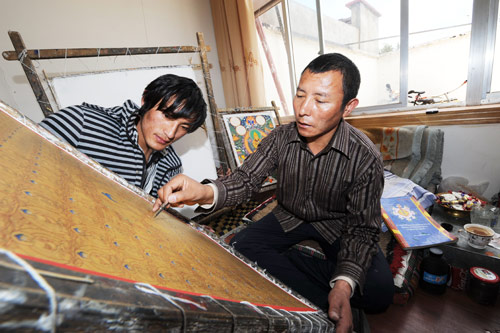Pious paintings
Updated: 2012-11-26 09:54
By Chen Nan (China Daily)
|
|||||||||||
 |
|
Zekyid learns thangka painting from his teacher Phuntso Dorje at Pandedajie School in Lhasa. |
"I want to share thangka culture with people and pass it down to another generation."
Thangka has been included on the National Intangible Cultural Heritage List since 2006. The show's artists practice the Menbris style of thangka painting that has flourished since the 15th century.
The 10 painters, who have studied thangka for more than seven years, come from Pandedajie School, founded by Fujian province native Zhang Li.
Zhang, who has owned two real estate consulting companies, visited Tibet in 2000. She fell in love with the pure and holy land, and was especially amazed by thangka, which she first saw in an ancient temple.
Her understanding of money transformed when she realized her 2,000 yuan ($321) jeans cost as much as a semester of school for 200 students.
"I don't want to give them money or donate clothes because that doesn't comprehensively solve the problem," she says.
In 2003, she decided to open a charitable school that offers free classes to poor students.
The name, Pandedajie, according to Zhang, means "benefiting others" and "spreading" in Tibetan.
The school offers sustainable ways to help children learn skills and earn livings after graduation. Zhang visited Tibet's temples to find teachers. A year later, the school opened in Lhasa.
The school's teacher is 46-year-old Phuntso Dorje, who was born in Xigaze.
He became a monk at 16 and learned thangka painting under Tashilhunpo Monastery's chief painter Kelsangla for four years.
Since then, he has continued to study with Lozangla, the painter of 10th Panchen Lama of the Tashilhunpo Monastery.
He also became the first person to publish an instructional book about thangka painting in 2006.
The painters always start with the deities' heads. They must know Tibetan and Buddhist history, and also be skilled at fresco painting and repair.
The deities express their thoughts through specific hand gestures. There are many rules about their depictions that have been passed down for centuries.
Related Stories
Education boosts role of local women 2012-11-07 10:21
Tibet school finds that pairings remove barriers 2012-11-15 09:39
Culture Week opens in Warsaw 2012-11-07 10:14
China Tibetan Culture Week opens in Poland 2012-11-06 16:20
Artist captures colors of Tibet 2012-11-02 09:06
Today's Top News
Rescuers race against time for quake victims
Telecom workers restore links
Coal mine blast kills 18 in Jilin
Intl scholarship puts China on the map
More bird flu patients discharged
Gold loses sheen, but still a safe bet
US 'turns blind eye to human rights'
Telecom workers restore links
Hot Topics
Lunar probe , China growth forecasts, Emission rules get tougher, China seen through 'colored lens', International board,
Editor's Picks

|

|

|

|

|

|





